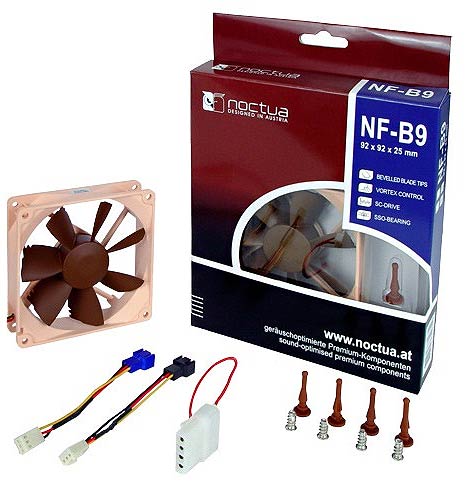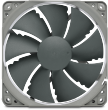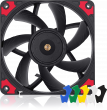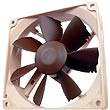NF-B9 Vortex-Control 92mm Quiet Case Fan Discontinued | |
| More variations available Show | |
Noctua NF-B9 Vortex-Control 92mm Quiet Case Fan

The NF-B9’s highly-optimised blade design achieves an exceptional level of airflow and static pressure that most other fans can only reach at much higher speeds. Bevelled blade tips, Vortex-Control Notches as well as Noctua’s SC drive system and premium-grade SSO-Bearing which possesses a built in stabilising magnet, ensure outstanding quietness and long-term stability.
Features
- 1600 RPM @ only 17.6 dB(A)
- Vortex-control notches
- Smooth commutation drive
- SSO bearing (self-stabilising oil-pressure magnetic bearing)
- Six years warranty
Review
XS Reviews.co.uk
The figures are awesome, and there aren’t any other competitors that I know of in the fan market at this CFM for their dBA level. Couple with the 3 pin to molex converter and provided anti-vibration pegs, and you have the perfect silent fan.
| Specifications | NF-B9 |
|---|---|
| Size | 92x92x25 mm |
| Bearing | SSO - Magnetic Bearing |
| Blade Geometry | NF-B9 Blade Design |
| Rotational Speed (+/- 10%) | 1600 RPM |
| Rotational Speed with L.N.A. (+/- 10%) | 1300 RPM |
| Rotational Speed with U.L.N.A. (+/- 10%) | 1000 RPM |
| Airflow | 37.8 CFM |
| Airflow with L.N.A. | 31.0 CFM |
| Airflow with U.L.N.A. | 24.2 CFM |
| Acoustical Noise | 17.6 dB(A) |
| Acoustical Noise with L.N.A. | 13.1 dB(A) |
| Acoustical Noise with U.L.N.A. | 7.9 dB(A) |
| Static Pressure | 1.61 mm H2O |
| Static Pressure with L.N.A. | 1.09 mm H2O |
| Static Pressure with U.L.N.A. | 0.64 mm H2O |
| Input Power | 1.32 W |
| Input Current | 0.12 A |
| Voltage Range | 12 V |
| MTBF | 150.000 h |
| Warranty | 72 months |
| EAN barcode | 4716123312819 |
| Specifications | NF-B9 |
|---|---|
| Size | 92x92x25 mm |
| Bearing | SSO - Magnetic Bearing |
| Blade Geometry | NF-B9 Blade Design |
| Rotational Speed (+/- 10%) | 1600 RPM |
| Rotational Speed with L.N.A. (+/- 10%) | 1300 RPM |
| Rotational Speed with U.L.N.A. (+/- 10%) | 1000 RPM |
| Airflow | 37.8 CFM |
| Airflow with L.N.A. | 31.0 CFM |
| Airflow with U.L.N.A. | 24.2 CFM |
| Acoustical Noise | 17.6 dB(A) |
| Acoustical Noise with L.N.A. | 13.1 dB(A) |
| Acoustical Noise with U.L.N.A. | 7.9 dB(A) |
| Static Pressure | 1.61 mm H2O |
| Static Pressure with L.N.A. | 1.09 mm H2O |
| Static Pressure with U.L.N.A. | 0.64 mm H2O |
| Input Power | 1.32 W |
| Input Current | 0.12 A |
| Voltage Range | 12 V |
| MTBF | 150.000 h |
| Warranty | 72 months |
| EAN barcode | 4716123312819 |
Customer Reviews
Think I'll be pleased, but can't say right now
Bought these to replace HDD fans in my Supermicro SC742 case. For those that don’t know, that has hot-swappable fans that sit in little caddies with miniature four pin fan connectors, on quite short leads. The fans have the more common miniature three pin on quite long leads. I thought I could unsolder the wires/tails but, no, sadly you can’t access the solder connections even if you peel the sticker back. You’d have thought these sort of specialist fans would cater for specialist users and perhaps be even sold with no leads so users can fix their own. But I need first do a bit of surgery to chop the existing wire and connector then splice - at staggered points along the fan support arm - the existing wires into those of the fans I’m replacing. But all that aside, quiet fans trade air volume for low noise. These seem, from initial test out of the case using the four pin Molex connector, to be on the impressive and good side of that equation. So, think I’ll be pleased (in the end).
VERY PRODUCTIVE BUT QUIET !
I installed this Noctua NF-B9 case fan together with Scythe Shuriken rev.B CPU cooler. Following this transaction with Quietpc.com MY PC HAS DISAPPEARED! It wasn’t stolen! It got soooo quiet that I was initially worried installation went wrong. But it went OK (although it took some fiddling) and I can hear no more spinning and howling of my 3-years old CPU cooler’s fan. And that happened on my 3-years old Dell PC equipped with Intel Core 2 Duo at 2,33Ghz. What’s more, nearly all temperature records have fallen sharply (values after slash with new cooler and case fan): Core 0: (idle state) 52’C/40’C; min.: 38’C/40’C-max.: 66’C/51’C; Core 1: (idle state) 53’C/43’C; min.: 43’C/44’C-max.: 68’C/55’C; Fan speed records (Noctua fan using top speed cable): 0: min.: 1650rpm/1030rpm-max.: 4500rpm/1150rpm; 2: min.: 1100rpm/590rpm-max.: 2600rpm/830rpm; Only my graphic card temperature has gone up by about 8-13’C (still not more than67’C). The only drawback - a very gentle resonance of PC case.
Nice quality fan
I got one of these to replace the old fan in my HP Pavilion Home Media Center PC. It fitted easily using the original screw holes in the PC case. The rubber mounts were a little tricky to pull through the holes in the fan: I was worried I’d break them, but they all came through without any damage. I’m running the fan at its full speed (without the reducer cables) and it’s more effective than the old fan, as well as quieter.
quiet
It’s extremely quiet, but it isn’t cooling as good as my old noisy one, I’ve ordered one more, just smaller. It’s really good stuff, you can’t hear a thing :)
very satisfied
I fitted it at the back of my rig. easy setup, although it took me a while to fit it without taking mobo first - I used those rubber parts instead of regular screws. quiet as advertised. I can hear only the sound of air moved if I place my ear within roughly 20-30cm. i slowed id down as much as i could. recommend!
Pretty in pink - and brown!
Ignore the curious colour scheme. This fan is whisper quiet whilst shifting large amounts of air at max revs. Fitted as an exhaust fan to an old Antec case and has helped manage a heat problem arising from a complete CPU/mobo/graphics upgrade. No need to change the case now!
Why 9 stars then? One of the anti-vibration rubber mountings tore during installation…and that was after a smear of silicon grease too!
Product Resources
FAQ
How do I measure fan size?
The size of fan you need will generally be determined by the size of the fan fitting position in your PC case. The sizes of all the fans on our website are shown as measured along any one of the fan’s four sides, NOT the distance between the fan’s screw holes! Our most popular fan size is 120mm, followed by 80mm. This isn’t really dictated by customer preference, but more by recent designs of PC cases.
As for the thickness (depth) of the fan, generally 25mm (1 inch) is by far the most common depth, although smaller fans can have shallower depths such as 15mm or even 10mm. All our fans are 25mm thick unless otherwise stated. If you have any questions about which fan you should order, please don’t hesitate to get in touch.
If you know the distance between the fan mounting screw holes but don’t know what fan size to order, please see the following table. Note that the mounting hole measurements shown below are taken horizontally or vertically between the holes and not diagonally.
Screw hole spacings and fan sizes
Space Between Screw Holes Fan Size 32mm 40mm 40mm 50mm 50mm 60mm 60mm 70mm 72mm 80mm 83mm 92mm 105mm 120mm I received a small cable (resistor) with my fan; what is it for?
The resistor cable (also called Ultra Low Noise or ULN cable) is designed to allow the fan to run slightly slower for even quieter operation. The benefit in lower running noise is significant. Although the airflow will be reduced slightly, this usually has minimal effect on PC temperature. We would generally recommend using the ULN resistor cable for best results in almost all circumstances.
How can I tell which way the air blows through the fan?
Hold the fan so that the round fan sticker is facing you. You are looking at the rear of the fan. When you plug the fan in, the air will be blowing towards you. If you want a fan to act as an air intake, then the fan sticker will be facing the inside of the case. Some fans also have two small arrows moulded into their plastic housing - one arrow shows the direction of airflow, and the other (at 90°) shows the direction of blade rotation.
Is it possible to use a 4-pin PWM fan or CPU cooler with a motherboard which has only 3-pin fan headers on it?
Electrically, there is no problem doing this - the fourth pin on the fan cable is used purely for PWM control and is not needed in order for the fan to run. So you can plug the 4-pin fan connector onto the 3-pin motherboard fan header, leaving the fourth pin not connected to anything. The fan will potentially run at full speed, so if you would like to reduce the speed of the fan you will need to adjust the fan speed setting in your BIOS or use fan control software such as SpeedFan in Windows.
The only other problem to consider is that occasionally, components immediately adjacent to the motherboard fan header can get in the way of the larger 4-pin fan connector, physically preventing connection. This problem also occurs if you try to use an in-line fan speed controller such as the one made by Gelid.
Another avenue to explore is the possibility of using a bay-mounted fan controller. Several models are available now which provide 4-pin fan headers, so this is an easy way to use 4-pin PWM fans in a PC system which has only 3-pin fan headers on its motherboards. When using this method, you may find it necessary to disable any fan warning settings in your motherboard BIOS, since the motherboard may incorrectly believe that its CPU fan has failed when the fan is connected to a fan controller rather than directly to the motherboard itself.
Top Quiet Fans

Noctua NF-A12x25 PWM chromax.black.swap 12V 2000RPM 120mm Fan

Noctua NF-P12 REDUX PWM 12V 1700RPM 120mm Quiet Case Fan

Noctua NF-S12B REDUX 12V 700RPM 120mm Quiet Case Fan

Noctua NF-F12 iPPC PWM 12V 2000RPM 120mm High Performance Fan

Noctua NF-F12 iPPC PWM 12V 3000RPM 120mm High Performance Fan

Noctua NF-A14 PWM chromax.black.swap 12V 1500RPM 140mm Fan

Noctua NF-A12x25 PWM 12V 2000RPM 120mm Ultimate Quality Quiet Fan

Noctua NF-A14 PWM 12V 1500RPM 140mm Premium Quality Fan

Noctua NF-A12x15 PWM chromax.black.swap 12V 1850RPM 120x15mm Fan

Noctua NF-A6x25 PWM 12V 3000RPM 60x25mm Low Noise Fan

